#IndiGo Airlines New Flights
Explore tagged Tumblr posts
Text
IndiGo Airlines new flights from Mangaluru, Coimbatore, and Tiruchirappalli to Abu Dhabi, starting August 2024 It hopes to boost South India to UAE connectivity
0 notes
Text
Understanding Aviation: Enemy's enemy is a friend
Recently, Air India announced the return to Kuala Lumpur with flights between Delhi and Kuala Lumpur starting September 01,2024. The timings favour connectivity to Europe via Delhi and eliminates the need of having double daily flights like in case of Phuket or only a good one way connectivity in the case of Ho Chi Minh City. I received quite a few messages asking me to mark this under…
#6E MH codeshare#AirAsia#AirAsia Bhd#India - Malaysia flights#Indian Aviation#Indian aviation blogs#Indian aviation news#Indian aviation updates#IndiGo#IndiGo Malaysia Airlines codeshare#IndiGo to Kuala Lumpur#Malaysia airlines#Understanding Aviation
0 notes
Text
IndiGo| goair | indigo airlines | airlines | indigo flight | indigo careers | indigo news
Indigo and Go First are getting the cheapest tickets of the year, get only 6139 International Flight chance Passengers can travel from March 12 to September 30, 2023। But for this you have to book tickets by 24 February Do you plan to roam this year? You do not have to worry because you are getting a chance to travel cheaply by September this year। Two of the country’s major airlines have…

View On WordPress
0 notes
Text
India’s $13.9 billion aviation industry—projected to cater to over 300 million domestically by 2030—is a ticking time bomb.
This July, in the sweltering heat at the Delhi High Court, additional solicitor general Aishwarya Bhati announced that new rules on pilot duty and rest periods would not be implemented this year after all. Introduced by the Directorate General of Civil Aviation (DGCA) in January, the rules were designed specifically to combat pilot fatigue. They were set to take effect in June, but were abruptly retracted. The hearing addressed a writ petition filed by the Federation of Indian Pilots (FIP), seeking clarity on when the new norms would be enforced. The DGCA’s response followed its request to airline companies in April for a tentative implementation timeline.
Concerns over pilot fatigue had been mounting in the months leading up to the announcement of the new Flight Duty Period, Flight Time Limitations, and Prescribed Rest Periods by the DGCA. The urgency deepened in November 2023 when a 37-year-old Air India pilot, Captain Himanil Kumar, collapsed at Delhi Airport while training to fly the airline's Boeing 777 fleet, and later died at the hospital. Kumar was the second Indian pilot to die on duty within three months; in August, Captain Manoj Subramanyam, a 40-year-old IndiGo pilot, suffered a fatal cardiac arrest just minutes before his flight from Nagpur.
These back-to-back tragedies raised alarm in the industry. “Another young Indian pilot passed away today due to a suspected cardiac event,” reportedly tweeted Captain Shakti Lumba, a retired IndiGo VP who is now the president of the Professional Pilots Society in India (His tweet was since deleted.) “If this doesn’t convince the DGCA, civil aviation ministry, and airlines to urgently address the stress, fatigue, and anxiety among pilots, nothing will.”
The DGCA, India’s aviation watchdog, regulates the country’s Flight Duty Time Limitations (FDTL). At 13 hours of flight duty time, India’s FDTL is already demanding, but after the pandemic slowdown, increased route expansion and pilot shortages have forced many to fly beyond the recommended maximum of 60 hours a week, exacerbating crew exhaustion. The DGCA finally responded to the growing crisis by revising FDTL norms in January 2024.
The new guidelines increased weekly rest periods from 36 to 48 hours and introduced quarterly fatigue reports. Its scheduled implementation on June 1, 2024, was pushed back due to pressure from operators. An airline CEO, speaking anonymously to the Economic Times in January, claimed the proposed regulations would require a 20 percent increase in pilot numbers, which would escalate expenses and lead to huge numbers of flight cancellations. Still, the DGCA held firm on the FDTL implementation deadline till early March. By the end of the month, however, it appeared to have yielded to influence from the airline lobby. A notice on the regulator’s website announced the deadline had been deferred, without providing a reason or setting a new date.
The pilot fatigue problem isn’t unique to India. In January, two pilots for Indonesia-based Batik Air fell asleep for 28 minutes mid-flight, causing their plane to veer off course between Sulawesi and Jakarta. In April, unionized Virgin Atlantic pilots in the UK voted 96 percent in favor of pursuing an industrial action in response to rising fatigue. Earlier, the CEO of Wizz Air UK faced a backlash for urging crew members to push through their fatigue to avoid flight cancellations. In May, senior pilots at Virgin Australia raised safety concerns, claiming rostering systems were pushing them "to the limits.”
But in India, the belief that overwork and fatigue are not just acceptable but essential has become entrenched across industries. The aviation crisis is just the tip of the iceberg; it is the tech industry that is leading the charge. Last year, Infosys cofounder Narayana Murthy suggested that Indian youth should work 70 hours a week for the nation's development. Murthy’s advice came up at the Indian Parliament on the first day of its winter session and found support from a list of influential Indian tech leaders, including Bhavish Aggarwal, founder of India’s first AI unicorn, Ola Krutrim; Ayushmaan Kapoor, cofounder of the AI-powered customer platform Xeno; and even veterans like Sajjan Jindal, CEO and MD of JSW Group, and Vinod Khosla of Sun Microsystems. Almost all of them justified the extended work hours, which far exceed the maximum eight to nine hours per day stipulated by the International Labour Organisation and the Indian Labour Code, as necessary for strengthening India’s economy. “We have to make India an economic superpower that we can all be proud of,” Jindal wrote on X. He cited Indian prime minister Narendra Modi, “who works 14-16 hours everyday,”as a model. In July this year, the Karnataka State IT/ITeS Employee Union said the state government had plans to increase working hours in the sector from the current maximum of 10 hours (including overtime) to a staggering 14 hours a day. As the union planned massive campaigns to oppose the move, the labor minister stated that the push for the proposal had come from the companies.
The airline companies think they have a solution to the fatigue crisis: technology. IndiGo, India’s largest airline, announced it would be an “early adopter” of a wrist-worn fatigue-monitoring device it was developing with French defense and aerospace company Thales Group. The device can provide “detailed insights into demographic data, including routes, pairings, crew profiles, and more, going beyond traditional scheduling-focused biomathematical models,” the airline stated in a press release in September. The airline, which operates 2,000 flights daily and employs over 5,000 pilots, said the device would be rolled out after a proof-of-concept trial. No date for the rollout was announced.
Wearable activity trackers are not new to the aviation industry. IndiGo’s device sounds similar to Actiwatch, a now-discontinued line of research-grade actigraphs from Philips, used to monitor sleep patterns, study circadian rhythms, and track physical activity as part of an airline’s fatigue risk-management system. But they partly rely on performance tests and subjective measures, such as self-reporting, which often results in being targeted by the airlines, says Captain C. S. Randhawa, president of the Federation of Indian Pilots. Safety management systems on the whole tend to be neglected by operators and are viewed as an additional expense, says Captain Amit Singh of the NGO Safety Matters Foundation.
In May 2023, Air India launched safety management software called Coruson, as well as BAM (Boeing Alertness Model), a fatigue-mitigation tool integrated into its rostering system, which is used by airlines to create and manage pilot schedules. Coruson, developed by cloud software company Ideagen, centralizes, analyzes, and reports on safety-related data—such as incidents, hazards, and risk assessments. BAM, developed jointly by Boeing and the software company Jeppesen, predicts and manages pilot fatigue by analyzing flight schedules and performance data. These tools were designed to prevent the creation of fatiguing rosters and pairings, Air India CEO Campbell Wilson noted in an internal message to employees. The carrier also introduced two new digital tools for its crew—the Pilot Sector Report app, to help pilots easily submit information on flight performance, incidents, and observations post-flight; and DocuNet, a digital management system that facilitates the storage, retrieval, and sharing of documents (such as flight manuals, training records, and compliance documents).
Despite these measures, the airline was fined by the DGCA in March this year for violating FDTL limits and fatigue management rules. This May, Air India Express cabin staff called in sick en masse to protest against “mismanagement.” This followed a similar protest from the crew, mostly pilots, at Vistara airlines. Both Air India and Vistara are now owned by one of India’s largest conglomerates, the Tata Group, which took over the former from the Indian government in January 2022.
Twenty-five of those who called in sick at Air India Express were terminated. Others were reportedly served an ultimatum. Those sacked were later reinstated by the airline following an intervention by the chief labour commissioner. Nearly a week before, the regional labor commissioner of Delhi had allegedly written to the Tata group chairman pointing to “blatant violations of labour laws” and insisting the legitimate concerns of the cabin crew be looked into. According to CNBC, Vistara employees said the agitation at their end had to do with recent salary updates, which fixed pilot pay at 40 flight hours—down from 70. Protesting first officers claimed that the new salary structure would result in an almost 57 percent pay cut. Under the new terms they would also have to fly up to 76 hours to earn what they were previously earning at 70 hours.
To placate the pilots and get them back to work, management had assured them that salaries for the “extra working hours” would be credited once Vistara was integrated with Air India. At the time, two Air India pilots unions had written to the chairman of the company, saying that such issues were not isolated but systemic. Burnout was the other related issue, with many pilots complaining of inadequate rest and being pushed to their limits.
Captain Singh, a former senior manager at AirAsia, tells WIRED that such effects significantly increase the risk of accidents, but also adversely affect pilot health in the long run. Tail swaps—rushing between different types of aircraft to take off immediately after disembarking from another—have become more prevalent under the 13-hour rules, and can further contribute to exhaustion, as do hasty acclimatization and, most significantly, landing three, four, or more flights consecutively, which Captain Randhawa described as a “severe energy management challenge.”
In the 2024 “Safety Culture Survey” conducted by Singh’s Safety Matters Foundation in July, 81 percent of 530 respondents, primarily medium- to short-haul pilots, stated that bufferless rosters contribute to their fatigue. As many as 84 percent indicated concerns with the speed and direction of shift rotation. “That’s the problem with the new rostering softwares the operators are introducing,” a pilot from a private airline, who requested anonymity, says. “They’re optimizers designed to make pilots work every second of their 13-hour schedule, leaving no breathing room.” The buffer-deficient timetables push pilots to their limits, so any additional pressure—like unpredictable weather—can easily overwhelm them.
Solving this issue with wrist-worn fatigue-measuring devices is contentious. But that isn’t the only problem. A year since they were hyped up, the buzz around fatigue-management tech has all but fizzled out. There have been no updates from IndiGo about the wrist device. Neither IndiGo nor the Thales Group responded to requests to comment.
589 notes
·
View notes
Text
No. 40 - Southwest Airlines

One of my most requested posts, it's time to cover a carrier anyone who's flown in the US is probably very familiar with. After all, Southwest has for decades been the largest low-cost carrier in the world by both revenue and fleet size (though IndiGo is coming for that title).
Southwest's history is longer and more substantial than many may think, a central figure in the genesis of what we now know as the low-cost carrier. But one thing I think a lot of people know is their livery.
A common theme on this blog is trends in airline liveries - in particular, the modern trend towards the minimalist, sterile, underdesigned, and above all generic. As an anecdotal example, someone who lives near Boston's Logan Airport, the 16th-busiest airport in the US and 30th-busiest in the world, served by every major US airline and every major international carrier from countries within 787 range, were they to watch the takeoffs and landings, would be treated to the following...menagerie.
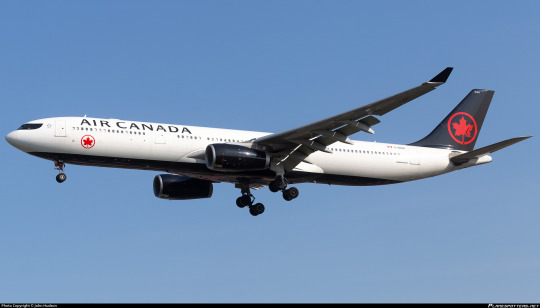
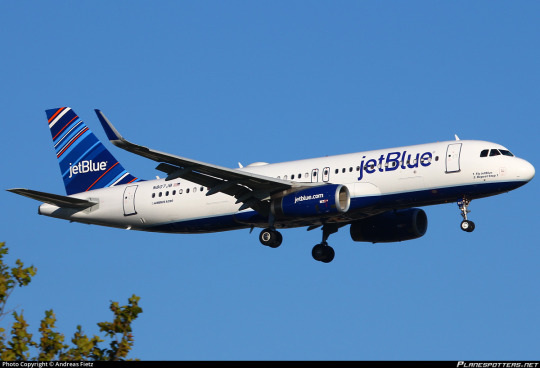
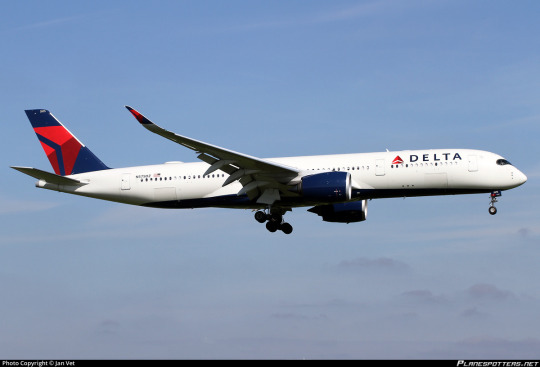
Can you believe these planes fly for different and indeed unrelated airlines?
Safe to say from 5,000 feet below it's a challenge to tell these planes apart. Even taxiing past them you'd need to pay attention. If I forced someone to squint I'm not sure they could identify them properly. How about Southwest?

Bam.
Southwest Airlines was founded in an era that borders on incomprehensible to those of my age bracket. The United States is a nation united in grumbling about Spirit Airlines, and most of Europe is constantly cursing Ryanair under their breath, but it wasn't always like that. The fact of a united enemy at all is new in the US. Back before the 1978 Deregulation Act, it was so prohibitively expensive to operate interstate flights that most airlines just didn't. Interstate flights were left to giant full-service airlines like Delta and Eastern, while international flights were the domain of an even more elite few - Pan Am, TWA, Braniff, and National (no, not that National, the other one) while the scrappier little companies flew short hops for commuters.
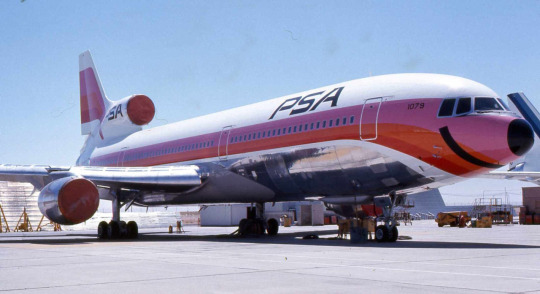
One airline which emerged in this pre-deregulation era was Pacific Southwest Airlines, commonly abbreviated to PSA, an initially tiny airline operating in California. You may recognize them from my icon! PSA is one of the single most important airlines in history because it all but invented the idea of the low-cost carrier. Beyond that, they were a Fun Airline. And while they were flying their grinningbirds all over California something else brewed in the background.

image: SouthwestArchive I have never before in my life seen such a profound pairing of undereye bags with the slicked-back hair and piercing blue eyes of a YA dystopia novel film adaptation villain, darting around to lock onto any sources of potential wealth ripe for acquisition.
In 1971 Southwest Airlines began operating flights. The company was actually incorporated in 1967 (as Air Southwest), the brainchild of then-lawyer Herb Kelleher (and two other people who nobody ever talks about because they're boring). They saw what PSA was doing and saw potential for the massive profits that could be gained from avoiding fees from operating interstate and charging drastically lower fees than the larger carriers. Unfortunately for them the larger carriers also realized this, and they were trapped for three years in lawsuit purgatory, with Braniff, Continental, and Trans-Texas Airways taking the case all the way to the Supreme Court, who apparently declined to review it, recognizing that 'they have come up with an idea that will make them make more money and us make less money' is not a particularly powerful legal argument.
And with that little hurdle over Southwest was open for business! Though they weren't quite starting out as a single rented DC-3 Kelleher very closely modeled the airline after PSA, who seemed to be okay enough with it if them helping to train mechanics at the nascent airline was any indication. After all, at this point they were both intrastate airlines fundamentally unable to compete with each other - Southwest was staying put in Texas with no reason to think this would change anytime soon. They brought a bit of PSA to the state, like the low fares and the stewardesses in hot pants and go-go boots.


So what was their answer to the grinningbird?

The rare and deeply cursed Southwest 727.
The mustard rocket. It was called "desert gold" but I think we all know that this is mustard. At this point in history brightly colored airplanes weren't even unusual either, so it would have just been regular ugly instead of ostentatious. (I mean...I like this shade of mustard yellow, honest, but I recognize that most people think this is hideous.)
Southwest kept on Southwesting from there. These days, they're massive, and the most common response on my questionnaire for best airline experiences. No comment, as I've never flown with them. Highlights of their journey there include getting a federal amendment passed because they didn't want to relocate their hub from Love Field to Dallas-Fort Worth, getting sued for only hiring female flight attendants, having the first Black chief pilot of any major airline in the US, technically legal tax evasion measures, having to invent elaborate work-arounds for the restrictions placed on them which could have been avoided by just relocating to Fort Worth, absorbing a bunch of other airlines, being the launch customer for both the -300 and MAX 8 models of the Boeing 737, and making approximately a zillion dollars. In 1990 they absorbed Morris Air, a vacation charter airline which developed innovative cost-cutting measures like e-ticketing, including high-up positions on the Southwest corporate ladder for the founders...
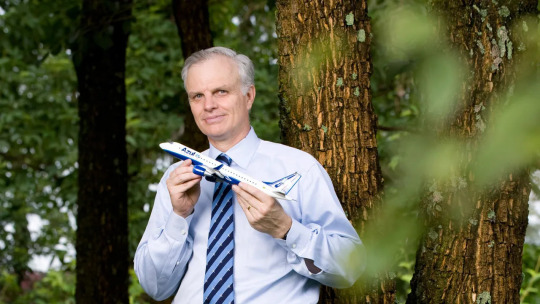
image: conde nast traveller Strange millionaires lurking in woods distributing model airplanes is no basis for an airline industry! ...scratch that, it does appear to be working.
...oh, for heaven's sake, there he is again. Yes, David Neeleman's cost-cutting acumen was indeed put to use at Southwest, meaning that between this and founding jetBlue he basically created low-cost carriers. I reluctantly tip my hat to the man. I would not be able to afford airline tickets without him. But he's just everywhere.
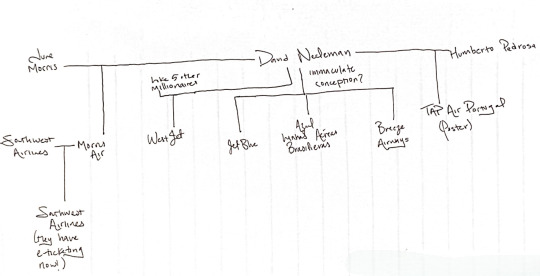
Here is my handwritten faMintly tree. Southwest is jetBlue's cousin once removed, do with that what you will. Anyway, let's hope I never have to add to this. (Not least because I already binned the piece of paper I wrote this out on.)
The turn of the century brought new things for Southwest! In 2000 they had their first major accident (a nonfatal runway overrun resulting in loss of the aircraft). Unrelatedly, in 2001 they released a new color scheme for their fleet, now several hundred strong and entirely composed of assorted models of Boeing 737.

The era of Canyon Blue had begun.

I mean, it's a statement. At this point a plane painted to look like a poisonous frog was in fact a pretty major statement. They were setting out to be an eyesore and I'm sure people were upset about this one, but to the modern eye it looks muted and unfinished. Still bluer than anything David Neeleman had made at that point, but not quite what we know today.

Okay. Yes. There we go.

This livery is meant to be the heart from their logo, the same one worn where the plane's heart might be if planes had hearts instead of air-conditioning systems, the colors unwrapped and deconstructed. And boy, is it almost violently colorful! It goes so far that it takes a minute to notice only three colors, plus white, are used in the entire livery. It's almost eyestraining, and I did have to turn the contrast down on my monitor while writing this because I'm fairly photosensitive. It's...less painful when pixels aren't involved.
So this is definitely one-of-a-kind. Well, it was. jetBlue has made choices recently. But this livery is definitely not one that gets lost in the crowd.
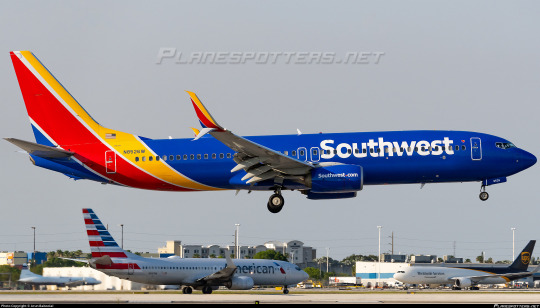
There's very little white or even silver on this airframe, in sharp contrast with...basically every airline. The rest of the livery is vivid and searing yellow and red, unusual shades in airlines, which tend to stick to slightly more muted schemes. And if you couldn't tell who they were by that, the big white billboard wordmark would let you know real quick. I think the white is a bit less legible than I'd like, but I'm not sure how to improve that without making it genuinely eyestrainy. At least it's large and visible, which is crucial for a low-cost carrier, instead of subtle and out of the way on the tail. That might work for an airline with a prestigious air, but that's not Southwest. Southwest is blue and yellow and red.
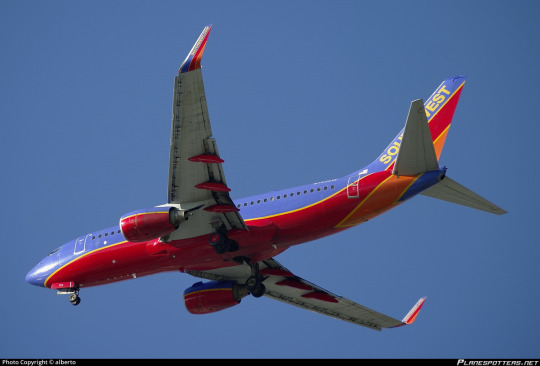
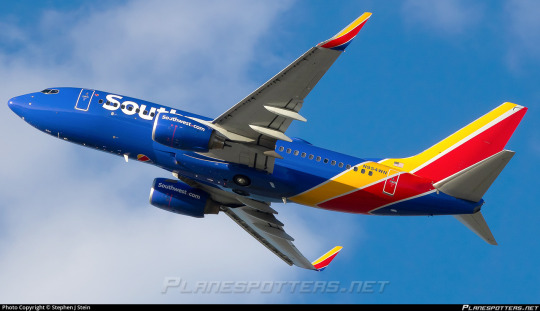
The main differences between the modern livery and Canyon Blue are in the placement of the logo and the colors used. Each shade is brightened significantly, which is why the once-garish Canyon Blue now looks pretty dusty in comparison. They entirely removed the blue from the tail, making it the airframe feel a little less like it's blue with accents and a little more like it's a circus tent. I do wish the yellow and red covered a bit more of the belly, but still...wow.

Some uses of Southwest Sans demonstrated.
The success of this design isn't by accident. Apparently, Southwest consulted no fewer than five design firms, and the font used for the livery and all their material (which I think looks totally fine) was actually commissioned from iconic foundry Monotype. A lot of airline liveries are designed in-house, and that can turn out fine, but Southwest clearly pulled out all the stops and it shows.

Southwest is a low-cost carrier, and this does affect the standards by which I judge their livery. They aren't here to be guided by legacy or decorum the way a flag carrier is - they're here to sell you a cheap ticket on an airline with funny cabin announcements. Circus tent with big lettering in a sea of Eurowhite? Nice, clean execution - I'd call that a job well done.
Grade: B

#tarmac fashion week#era: 2010s#era: 2020s#grade: b#region: north america#region: united states#low cost carriers#requests#southwest airlines#neelemanverse
41 notes
·
View notes
Text
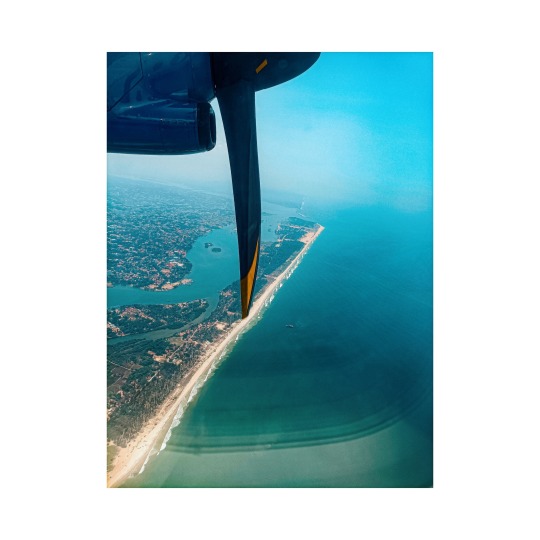
Coastal Aerial Vistas: A Glimpse from Indigo Flight over Mangalore
Flying over picturesque landscapes has always been an exhilarating experience, but nothing quite compares to the awe-inspiring beauty of coastal regions. The city of Mangalore, located on the pristine shores of the Arabian Sea in southern India, offers an extraordinary blend of natural splendor and vibrant culture. As I recently embarked on a journey with Indigo Airlines, I had the privilege of witnessing breathtaking coastal aerial vistas that left me speechless. Join me as I recount this remarkable journey and share the indelible impressions etched in my memory.
The Aerial Perspective:
As the Indigo flight soared into the skies above Mangalore, my heart raced with anticipation. The view from above provided an entirely new perspective of the coastal city. From the airplane window, I was treated to a panoramic tapestry of vivid blues and greens, where the cerulean waters merged seamlessly with the lush greenery of the surrounding landscape. The aerial vantage point revealed a coastline dotted with palm-fringed beaches, winding rivers, and estuaries that stretched far into the distance.
Coastal Charm:
The coastline of Mangalore is a true testament to the splendor of nature. From high above, I witnessed the rhythmic dance of waves crashing against the shorelines, leaving trails of foamy white surf in their wake. The sandy beaches, basking in the warm sunlight, beckoned visitors with their promise of tranquility and relaxation. The vibrant hues of parasols dotted along the shoreline added a playful touch to the otherwise serene scene.
As the aircraft cruised over the city, I marveled at the blend of old-world charm and modern development. The historic buildings, painted in vibrant colors, stood as proud reminders of Mangalore's rich heritage. Meanwhile, the city's rapid growth was evident in the sprawling urban landscape and the bustling port area, which served as a lifeline for trade and commerce.
Natural Wonders:
Beyond the city limits, the coastal region of Mangalore revealed its true natural wonders. The flight granted me a privileged view of the lush mangrove forests that fringe the riverbanks. These ecologically rich habitats serve as sanctuaries for numerous bird species and play a vital role in preserving the delicate coastal ecosystem.
Further inland, I witnessed the majestic Western Ghats mountain range rising like a sentinel, its peaks shrouded in a mystical haze. These ancient mountains are a treasure trove of biodiversity, hosting an incredible array of flora and fauna. The verdant valleys, nestled between the mountains, seemed untouched by time, inviting adventurers and nature enthusiasts to explore their hidden trails.
Conclusion:
My journey with Indigo Airlines provided an extraordinary opportunity to witness the unparalleled beauty of Mangalore's coastal vistas from the skies. The picturesque landscapes, the mesmerizing hues of the Arabian Sea, and the blending of nature and culture left an indelible mark on my soul. From the aerial perspective, I gained a deeper appreciation for the fragile balance between human development and the preservation of natural wonders.
Whether you're a seasoned traveler or a wanderlust-driven dreamer, I highly recommend experiencing the coastal splendors of Mangalore from the heights of an airplane. Let the gentle breeze against your face and the breathtaking vistas unfold before your eyes. It is a glimpse of paradise that will forever remain etched in your heart.
So, the next time you embark on a journey, choose the window seat, fasten your seatbelt, and prepare to be captivated by the coastal aerial vistas that await you on an Indigo flight over Mangalore.
3 notes
·
View notes
Text
Goa to Mumbai Flights: A Quick Journey from Beaches to the Bustling Metropolis
Traveling from the tranquil beaches of Goa to the bustling city of Mumbai is seamless and efficient with frequent flights connecting the two destinations. Whether you’re heading to Mumbai for business, entertainment, or a layover to your next destination, a flight offers the fastest and most convenient way to make this journey.
Flight Overview
The distance between
Goa to Mumbai Flights
is around 590 kilometers, and a direct flight typically takes just 1 to 1.5 hours. Several airlines, including IndiGo, Air India, Vistara, SpiceJet, and Go First, operate daily flights on this route, ensuring flexibility and convenience for travelers.
With frequent departures from early morning to late evening, you can easily find a flight that suits your schedule.
Airports and Connectivity
Departure: Goa International Airport (GOI), Dabolim Goa’s airport, located in Dabolim, is the primary gateway for domestic and international travelers. It offers comfortable lounges, shopping outlets, and dining options to enhance your travel experience.
Arrival: Chhatrapati Shivaji Maharaj International Airport (BOM), Mumbai Mumbai’s airport is a major travel hub with world-class facilities. It provides easy access to the city via taxis, ride-hailing services, buses, and the metro. The airport’s Terminal 2 is renowned for its modern design and efficiency.
When to Travel
Peak Season (November to February): Perfect for enjoying Goa’s vibrant weather before transitioning to Mumbai’s cool winter vibes.
Monsoon Season (June to September): The lush landscapes of Goa give way to Mumbai’s dramatic rains, making the journey uniquely scenic.
Booking Tips
Book in Advance: Goa to Mumbai is a busy route, so early bookings can help you secure the best fares.
Travel Light: Stick to carry-on luggage to avoid extra fees and save time at baggage claim.
Track Discounts: Use flight comparison tools and look out for promotions for additional savings.
Why Choose a Flight?
Flying from Goa to Mumbai is the fastest way to connect these two destinations, saving you valuable time compared to train or road travel. With a short flight duration and frequent options, you can maximize your time enjoying both the serene beaches of Goa and the dynamic energy of Mumbai.
Conclusion
Whether you're ending your Goan vacation or starting a new adventure in Mumbai, a flight ensures a comfortable and efficient journey. With easy booking options and multiple daily flights, this quick trip lets you transition seamlessly between relaxation and urban excitement.
Pack your bags and get ready for a smooth journey from paradise to the city of dreams! ✈️
0 notes
Text
Jewar international airpots news
Jewar International Airport, also known as Noida International Airport, is making significant progress toward its opening. The first phase is scheduled to begin commercial flight trials on November 30, 2024, with airlines such as IndiGo and Akasa Air participating. The airport will feature one runway and a terminal with a capacity to handle 12 million passengers annually, expanding to 70 million passengers in later phases. Full operations are expected to begin by April 2025
For more information go in — kaizeninfraedge ( website )
1 note
·
View note
Text
Ahmedabad to Delhi Flights: Everything You Need to Know Before You Travel
Ahmedabad to Delhi flights connect two of India’s most prominent cities, offering convenience and efficiency for travelers. Whether it’s a business trip or a leisurely getaway, understanding the nuances of this route can make your travel experience seamless and enjoyable.
Flight Options on the Ahmedabad to Delhi Route
The Ahmedabad to Delhi route is one of the busiest in the country, serviced by several airlines including IndiGo, SpiceJet, Air India, and Vistara. With multiple daily flights, travelers have a range of options to choose from, including budget and premium carriers.
Duration and Distance
The distance between Ahmedabad and Delhi is approximately 950 kilometers. Ahmedabad to Delhi flights typically take around 1.5 to 2 hours, making it a quick and hassle-free journey.
Booking Your Flight
To secure the best fares, book your Ahmedabad to Delhi flights early. Airlines frequently offer discounts during off-peak travel times, and booking at least a month in advance is recommended. Fare comparison websites can help you find the best deals.
Airport Information
Ahmedabad’s Sardar Vallabhbhai Patel International Airport is well-connected to various parts of the city, making it convenient for travelers. In Delhi, the Indira Gandhi International Airport offers excellent connectivity to the city center and surrounding areas through taxis, metro services, and buses.
What to Expect In-Flight
Depending on the airline you choose, Ahmedabad to Delhi flights may offer amenities like complimentary snacks, meals, or in-flight entertainment. Budget airlines may have a no-frills approach, so plan accordingly if you need extra services.
Best Time to Fly
Morning and evening Ahmedabad to Delhi flights are the most popular among business travelers. If you’re looking to save money, opt for midday or late-night flights, which are often less crowded and more affordable.
Tips for a Smooth Journey
Check-In Online: Save time at the airport by checking in online and choosing your preferred seat.
Arrive Early: Arrive at least two hours before departure to complete security checks and boarding comfortably.
Stay Updated: Keep an eye on flight updates via the airline’s app or website to avoid last-minute surprises.
Exploring Delhi After Your Flight
Delhi offers a plethora of attractions, from historical landmarks like the Red Fort and Qutub Minar to bustling markets like Chandni Chowk. With easy connectivity from the airport, you can dive straight into exploring the city after your Ahmedabad to Delhi flight.
Conclusion
Ahmedabad to Delhi flights provide an efficient and affordable way to travel between two dynamic cities. With a plethora of options and amenities, you can tailor your journey to suit your preferences. Plan your trip today and enjoy a seamless travel experience!
#Ahmedabad to Delhi flights#bengaluru to varanasi flight#bengaluru to bagdogra flight#amritsar to goa flight#chennai to dehradun flight#mumbai to varanasi flights#ahmedabad to bhubaneswar flight
0 notes
Text
IndiGo has launched a direct connection between Bengaluru and Mauritius, marking its 35th international route. The airline will operate four weekly flights on this new path, offering a quick, five-and-a-half-hour journey. Source [ad_2] Source link
0 notes
Text
IndiGo has launched a direct connection between Bengaluru and Mauritius, marking its 35th international route. The airline will operate four weekly flights on this new path, offering a quick, five-and-a-half-hour journey. Source [ad_2] Source link
0 notes
Text
Boost Your Travel Business with an Advanced Airline Ticket Booking Portal

Travel companies are adopting cutting-edge technology in today's hectic environment to streamline their operations and deliver top-notch client service. A key tool that improves productivity and creates a smooth ticket purchase experience is an airline ticket booking portal. Top airlines like IndiGo, Vistara, Air India, SpiceJet, and Akasa Air are accessible to travel brokers through platforms like Fly24hrs, allowing them to provide their customers with unmatched services.
This blog will walk you through what an airline ticket booking portal is, how it works, and how leveraging leading airlines' unique features can drive your travel business to new heights.
What is an Airline Ticket Booking Portal?
An online tool that links airlines and travel agencies and provides convenient ways to search for flights, compare prices, and buy tickets is called an airline ticket booking portal. Using Fly24hrs, agents benefit from:
Real-time flight schedules and updates.
Access to multiple airlines, catering to diverse customer needs.
A user-friendly interface that ensures quick and accurate bookings.
How Does an Airline Ticket Booking Portal Work?
Fly24hrs integrates directly with airline systems, delivering a hassle-free booking experience:
Access Real-Time Flight Information: Stay updated with the latest schedules and fares from top airlines like Vistara and IndiGo.
Search and Compare Flights: Explore flight options across airlines such as SpiceJet, Akasa Air, and Air India to find the best deals for your clients.
Book and Manage Tickets: Effortlessly complete bookings and manage reservations, saving valuable time.
Highlighting Top Airlines Available on Fly24hrs
Let’s take a closer look at the airlines accessible on the Fly24hrs platform and their standout features:
1. IndiGo
A leader in India’s aviation market, IndiGo is known for:
A vast domestic network reaching tier-2 cities and major hubs.
Excellent on-time performance for hassle-free travel.
Budget-friendly fares, making it a go-to choice for price-conscious travelers.
2. Vistara
For tourists looking for first-rate experiences, Vistara provides:
India’s first premium economy seating.
Top-notch in-flight amenities, including gourmet dining.
A growing international network ideal for business and luxury travelers.
3. Air India
Air India, India's flag carrier, blends history with wide-ranging international connectivity:
An extensive network to Europe, the Americas, and Asia.
A rewarding frequent flyer program.
Spacious seating and full-service options, perfect for long-haul travel.
4. SpiceJet
SpiceJet is renowned for offering high-quality, reasonably priced services.
Competitive pricing for budget travelers.
SpiceMAX and other upgraded seating options are more comfortable.
A strong domestic and regional network.
5. Akasa Air
Akasa Air, a more recent arrival, is revolutionising domestic travel by:
Modern aircraft for quieter, more comfortable journeys.
Eco-friendly practices for sustainability-focused travelers.
Affordable pricing that appeals to young and dynamic customers.
Why Choose Fly24hrs for Your Travel Business?
Fly24hrs is solely focused on providing travel agents with a booking platform that is easy to use and customised to meet their needs. It's the ideal business partner for the following reasons:
Save Time: Purchase tickets from several airlines, such as SpiceJet or Air India, without having to visit several websites.
Increase Revenue: To draw in more clients, provide affordable tickets from airlines like IndiGo and Akasa Air.
Provide Variety: Offer a variety of choices to suit different tastes, from deluxe Vistara experiences to more affordable solutions.
How to Use the Fly24hrs Portal
Getting started with Fly24hrs is simple:
Register: Make an account on the website.
Log In: To access the portal, enter your login information.
Search Flights: Enter your travel information and look through flights offered by airlines such as SpiceJet and Vistara.
Compare Options: Choose the best alternative for your clients by comparing fares and itineraries.
Book Tickets: Fill out the reservation and pay securely.
How Travel Agents Benefit from Fly24hrs
Fly24hrs provides travel brokers with a number of benefits:
Increased Efficiency: Easily manage several reservations.
Diverse Offerings: Give clients choices from a variety of leading airlines, ranging from low-cost options like Akasa Air to high-end services like Vistara.
Enhanced Credibility: For precise and prompt reservations, rely on a reliable website.
Conclusion: Fly24hrs – Your Trusted B2B Flight Booking Partner
Fly24hrs offers a comprehensive solution to streamline the booking process for travel agents wishing to improve their offerings. Fly24hrs helps agents to build their companies and provide better customer service by collaborating with leading airlines like IndiGo, Vistara, Air India, SpiceJet, and Akasa Air.
Are you prepared to revolutionise your travel company? Sign up with Fly24hrs now to see the difference!
#cheap flight ticket#b2b travel agent portal#flight booking online#b2b flight booking portal in india#b2b flight booking engine#best b2b travel portal#travel agent ticket booking portal#b2b portal
0 notes
Text
The one destination stations of IndiGo
IndiGo – the country’s largest airline has been growing rapidly in terms of both fleet, reach and expanse since 2018. I have often described the airline’s network and station selection as “find a station such that you can bombard it with flights from multiple different places’ ‘. This largely held true for its narrowbody network until it started flights in the North East and subsequently last…
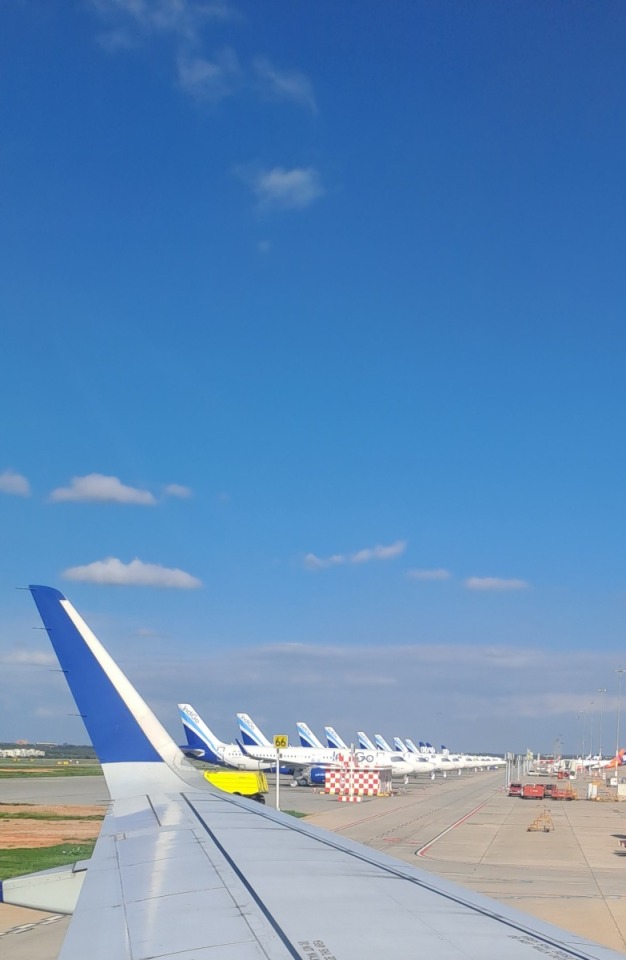
View On WordPress
#Aviation Blogs#Indian Aviation#Indian aviation blogs#Indian aviation news#IndiGo#IndiGo airline network analysis#IndiGo airline one flight stations#IndiGo network
0 notes
Text
Spotify Premium Subscription Free For THESE USERS; Check Offer Validity
Spotify Premium Subscription Free: Indian low-cost airline Indigo has rolled out a new offer for its domestic and international flyers. The airline company is offering a free membership of Spotify Premium, which is an audio streaming service that offers users access to multiple forms of streaming media, including music, podcasts, and audiobooks. The free subscription for eligible flight bookings…
0 notes
Text
Comparing Air Hostess Salaries at IndiGo and Air India, Benefits, Growth, and Opportunities

Becoming an air hostess is a dream job for many young people in India. Working in the aviation industry brings exciting travel opportunities, a chance to meet new people, and valuable experiences. But choosing the right airline can make a big difference in career growth, salary, and job satisfaction. This article will compare two leading airlines in India—IndiGo and Air India—focusing on salaries, benefits, growth, and opportunities for air hostesses.
1. Salaries: IndiGo vs. Air India
The salary of an air hostess can vary between airlines, job roles, and experience levels. Here’s a breakdown of salaries at IndiGo and Air India:
IndiGo: For a beginner, an air hostess at IndiGo can expect a monthly salary between ₹25,000 to ₹40,000. With experience, this amount can increase to ₹50,000 - ₹80,000 per month, depending on seniority and years with the company.
Air India: Air India offers a slightly higher starting salary, ranging between ₹30,000 and ₹45,000 per month. With experience, air hostesses at Air India can earn up to ₹90,000 or more monthly, especially for international flights, where allowances and incentives are higher.
Note: These figures are approximate and can vary based on routes, position (junior or senior), and additional allowances such as night stop allowances and international layovers.
2. Benefits and Perks
Both airlines offer a range of benefits to their air hostesses. However, some perks may differ.
IndiGo: IndiGo provides benefits such as medical insurance, travel allowances, discounted tickets for employees and their families, and meal allowances. IndiGo is also known for providing a good work-life balance, as it primarily operates domestic flights, allowing air hostesses to be home more often.
Air India: Air India provides similar benefits, including medical coverage, travel benefits for family members, and meal allowances. Air India, being a government-affiliated airline, sometimes offers additional perks, especially for international flights, including layover allowances, which add to the overall compensation.
3. Career Growth and Opportunities
Career advancement is essential for those looking to build a long-term career as an air hostess. Let’s explore the growth opportunities at both airlines.
IndiGo: IndiGo offers a straightforward career path. After joining as a junior air hostess, one can advance to senior air hostess roles and, eventually, become a cabin supervisor or lead crew member. Promotions are often based on experience, performance, and internal exams.
Air India: Air India also provides a well-defined career path. Starting as a junior air hostess, you can be promoted to senior roles, such as senior cabin crew, cabin supervisor, and even in-flight service manager. Air India also offers more opportunities for international travel, which can lead to additional allowances and unique travel experiences.
4. Work Environment and Culture
The work culture at IndiGo and Air India also impacts job satisfaction and employee experiences.
IndiGo: IndiGo is known for its young, vibrant, and customer-focused work culture. It has a reputation for punctuality and is quite popular among young professionals for its dynamic and efficient working environment. IndiGo operates mostly within India, which means air hostesses get to maintain a good work-life balance, and it has less rigorous international travel schedules.
Air India: Air India’s work environment is more traditional, as it’s one of India’s oldest airlines. Employees here often benefit from job stability due to its affiliation with the government. Working on international routes adds an exciting element, and employees may get exposure to different cultures and unique travel opportunities. However, the schedules may be more demanding, especially on international routes.
5. Pros and Cons Summary
Feature
IndiGo
Air India
Starting Salary
₹25,000 - ₹40,000
₹30,000 - ₹45,000
Max Salary
₹80,000
₹90,000+
Work-Life Balance
Better due to domestic focus
More demanding with international
Growth Opportunities
Defined path, promotions possible
Defined path with international focus
Travel Benefits
Family discounts, domestic flights
Family discounts, international focus
Work Culture
Young, dynamic
Traditional, stable
6. Which Airline is Right for You?
Choosing between IndiGo and Air India depends on your personal goals and lifestyle preferences. If you value a stable work environment with good work-life balance, IndiGo may be a better fit, as it focuses on domestic flights. However, if you’re interested in international exposure and the chance to earn higher allowances, Air India could be ideal.
7. Final Thoughts
Both IndiGo and Air India are great choices for building a career as an air hostess in India. Each offers competitive salaries, valuable benefits, and unique growth opportunities. Your choice will depend on the lifestyle you want and your long-term career goals. Whether you choose IndiGo or Air India, working as an air hostess is a rewarding experience that can lead to personal growth, exciting travels, and professional satisfaction.
Reference for website: - Flying Star Aviators
Reference for Air Hostess full info: - Air Hostess
#air hostess#air hostess in india#air india air hostess#air india air hostess salary#indigo air hostess salary#indigo air hostess salary in india#air india air hostess salary in india#how to become a pilot
1 note
·
View note
Text
Book Ahmedabad to Jaipur Flights: Hassle-Free & Affordable Options
If you're planning a journey from Ahmedabad to Jaipur, the best way to make your trip smooth and affordable is to find a cheap flight. With plenty of options for booking an Ahmedabad to Jaipur flight, you can easily select a flight that fits your budget and schedule. This guide will walk you through everything you need to know about booking flights, including tips on how to secure the best deals, the best time to book, and what to expect on your journey.
Why Book an Ahmedabad to Jaipur Flight?
Ahmedabad and Jaipur, two of India’s most vibrant cities, offer unique cultural and historical experiences. Whether you're traveling for business, a family visit, or a tourist getaway, flying between these two cities is convenient. With direct flights, you can cover the 660 kilometers in just about 1 hour and 30 minutes, making it an ideal choice for travelers who want to save time.
How to Find Cheap Flights from Ahmedabad to Jaipur
Finding a cheap Ahmedabad to Jaipur flight can be easy if you know where to look and when to book. Here are some key tips to help you secure affordable tickets.
1. Book Early to Save More
One of the simplest ways to save on your Ahmedabad to Jaipur flight is to book early. Ideally, try to book your flight at least 4 to 6 weeks in advance. Airlines often release discounted fares several weeks before departure, so the sooner you book, the better your chances of securing a lower price.
2. Use Fare Comparison Websites
Using flight comparison websites like Skyscanner, Kayak, or Google Flights can help you find the best deals. These platforms allow you to compare prices from various airlines and travel agencies, helping you find the cheapest Ahmedabad to Jaipur flight in just a few clicks. Don’t forget to set price alerts, as they notify you of price drops.
3. Consider Mid-Week Flights
Most travelers tend to book flights around weekends, driving prices up. To find a cheaper Ahmedabad to Jaipur flight, try booking your tickets for mid-week departures, such as Tuesdays or Wednesdays. Not only are flights typically less expensive on these days, but the airports may also be less crowded.
4. Use Airline Loyalty Programs and Travel Rewards
If you frequently travel within India, joining airline loyalty programs like IndiGo’s 6E Rewards or Air India's Flying Returns can provide access to exclusive discounts, reward points, and other perks. Accumulating miles over time can help reduce costs on future flights, including an Ahmedabad to Jaipur flight.
5. Look for Deals During Sales and Festivals
Airlines in India frequently offer special deals during festivals or holiday seasons. Keep an eye out for promotions around Diwali, New Year, and other major events. Sign up for airline newsletters to get notified about these deals so you can book an Ahmedabad to Jaipur flight at a lower price.
Top Airlines Operating Ahmedabad to Jaipur Flights
Several domestic airlines offer flights between Ahmedabad and Jaipur, making it easy to find an option that fits your travel needs. Here’s a list of some popular airlines:
IndiGo: Known for its budget-friendly fares, IndiGo offers multiple daily flights.
Air India: Air India offers full-service flights, which may be more expensive but include perks like meals and checked baggage.
SpiceJet: This airline provides budget options, and you may find great deals if you book early.
Go First: Another affordable airline option, known for its timely departures and comfortable service.
Flight Duration and Arrival Information
An Ahmedabad to Jaipur flight takes approximately 1 hour and 30 minutes. Flights depart from Sardar Vallabhbhai Patel International Airport (AMD) in Ahmedabad and arrive at Jaipur International Airport (JAI). Both airports offer various facilities such as lounges, restaurants, and shops to keep you comfortable while you wait.
Ahmedabad Airport
Ahmedabad’s Sardar Vallabhbhai Patel International Airport is a well-equipped airport that serves as a major hub in western India. Make sure to reach the airport at least 2 hours before your Ahmedabad to Jaipur flight to allow for security checks and boarding procedures.
Jaipur Airport
Once you arrive at Jaipur International Airport, you'll find taxis, app-based cabs, and car rental services available right outside the terminal. Jaipur’s airport is located about 13 kilometers from the city center, so you can reach your destination in around 30 minutes, depending on traffic.
Best Time to Book an Ahmedabad to Jaipur Flight
For the best chances of finding a cheap Ahmedabad to Jaipur flight, aim to book during the off-season. The peak travel season in Jaipur is during the winter months (October to February), so prices may be higher due to increased demand. By traveling in the shoulder months (March to April or September), you may be able to find lower fares.
What to Expect on an Ahmedabad to Jaipur Flight
Flights between Ahmedabad and Jaipur are short, so expect a quick and comfortable experience. Here’s a bit about what you can expect on board:
Baggage Allowance: Most airlines offer a free carry-on allowance, but check the airline’s policy on checked baggage to avoid extra fees.
In-Flight Services: Depending on the airline, you may be offered refreshments, but some budget airlines do not include meals in the ticket price.
Entertainment: Since the flight is short, in-flight entertainment may not be provided. Bring a book or download entertainment on your device in advance.
Additional Tips for a Smooth Journey
Check-In Online: To save time, use the online check-in option. Most airlines open online check-in 24-48 hours before departure.
Pack Light: If you’re flying with a budget airline, stick to the baggage limit to avoid additional fees.
Stay Updated on Flight Status: Check your flight status in advance to avoid any last-minute surprises. You can do this on the airline’s website or via a mobile app.
Conclusion: Book Your Ahmedabad to Jaipur Flight Today!
Booking a flight from Ahmedabad to Jaipur doesn’t have to be complicated or expensive. By following these tips and booking smartly, you can find a cheap Ahmedabad to Jaipur flight that meets your budget and travel schedule. Whether you're visiting the Pink City for its beautiful palaces or on a business trip, a flight is the quickest and most convenient way to get from Ahmedabad to Jaipur.
Start your journey today by comparing fares, booking early, and staying flexible. With a little planning, you can enjoy a hassle-free trip between two of India’s most charming cities. Safe travels!
0 notes